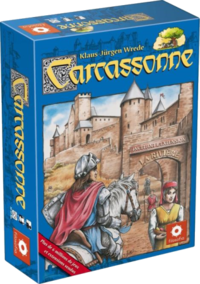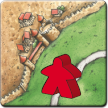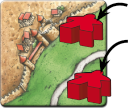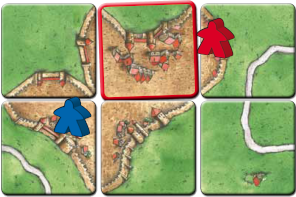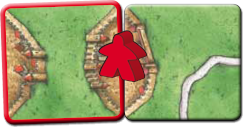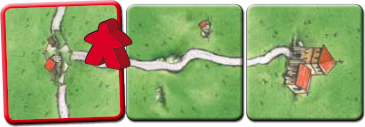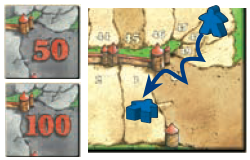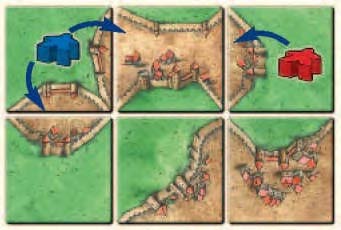Jeu de base (première édition)
 |
Vous êtes en train de lire les règles pour ce modèle de tuiles. |
 | Lisez les règles suivantes si vos tuiles ressemblent à ce type de tuile. |  |
| Si vos tuiles ont un motif différent, choisissez un jeu parmi les jeux dérivés. |  |
Informations générales et commentaires
Commercialisé à l'origine par Hans im Glück en 2000
Originally released by Hans im Glück in 2000
Un jeu de tuiles astucieux pour 2 à 5 joueurs âgés de 8 ans et plus par Klaus-Jürgen Wrede
La ville de Carcassonne, dans le sud de la France, est célèbre pour ses fortifications romaines et médiévales uniques. Les joueurs tentent leur chance avec leurs partisans dans les villes, les abbayes, les prés et sur les routes avoisinant Carcassonne. Le développement de la terre est entre leurs mains, et le déploiement habile des partisans en tant que voleurs, chevaliers, moines et paysans est le chemin vers la réussite.
Matériel
- 72 tuiles Terrain (incluant une tuile de départ avec un dos foncé) présentant des sections de villes, de routes, de prés, ainsi que des abbayes et des intersections.
- 40 partisans de 5 couleurs [1] :
Partisans en cinq couleurs
![]() Question : Trop peu de partisans — est-ce qu’on joue mal ou est-ce qu’il y en a vraiment trop peu ?
Question : Trop peu de partisans — est-ce qu’on joue mal ou est-ce qu’il y en a vraiment trop peu ?
Chaque partisan peut devenir chevalier, moine, voleur ou paysan. Un partisan de chaque couleur est utilisé pour marquer ses points.
- Un plateau de pointage, utilisé pour noter les points des joueurs.
- Un livret de règles et un supplément.
Règles
Aperçu du jeu
Les joueurs placent des tuiles tour après tour. C’est ainsi que les routes, les villes, les abbayes et les prés sont créés et développés. Les joueurs peuvent poser des partisans sur ces tuiles afin de marquer des points. Les points sont notés pendant et à la fin de la partie. Le joueur qui a le plus de points après le décompte final est déclaré vainqueur.
Mise en place
La tuile de départ est placée au centre de la table. Les autres tuiles sont mélangées, face cachée, et disposées en différentes piles de façon à ce que les joueurs y aient facilement accès. Les tuiles peuvent également être placées dans un sac ou une boîte de jeu et piochées au hasard. Le plateau de pointage doit être placé au bord de la table si possible.
Chaque joueur choisit une couleur, reçoit ses huit partisans et pose l’un d’eux sur la case « 0 » du plateau de pointage comme marqueur de score. Les sept partisans restant sont placés devant le joueur en guise de réserve personnelle.
Le plus jeune joueur décide qui commence le jeu [2].
Déroulement d’une partie
Les joueurs jouent chacun leur tour, en sens horaire. À son tour, un joueur doit effectuer les actions ci-dessous en respectant l’ordre suivant :
- Le joueur doit piocher et placer une nouvelle tuile Terrain.
- Le joueur peut prendre un partisan de sa réserve et le poser sur la tuile juste placée.
- Si, en plaçant la tuile Terrain, des abbayes, routes et/ou villes sont complétées, la ou les constructions complétées doivent être évaluées immédiatement.
Le tour du joueur est terminé et le joueur suivant effectue son tour de la même façon.
1. Placement d’une tuile Terrain
Pour débuter, un joueur doit piocher une tuile Terrain d’une des piles faces cachées. Il la regarde, la montre aux autres joueurs (afin qu’ils puissent lui donner des «conseils») et la place sur la table en observant les règles suivantes :
- La nouvelle tuile (avec un contour rouge dans les exemples suivants) doit être placée de façon à ce qu’elle touche au moins un côté adjacent d’une tuile placée précédemment. Le placement de coin à coin n’est pas autorisé.
- Les sections de prés, de villes et de routes doivent être placées de façon à continuer ou compléter les sections déjà en jeu. Une tuile Terrain nouvellement posée doit s’adapter au terrain adjacent sur tous ses côtés. Lors de la pose, cela ne suffit pas d’avoir un seul côté qui convienne.
Dans les rares cas où une tuile piochée ne peut être placée, et que tous les joueurs sont d’accord, elle est retirée du jeu, et le joueur en pioche une autre.
2. Pose d’un partisan
Une fois que le joueur a placé sa tuile, il peut poser un de ses partisans en prenant soin d’observer les règles suivantes :
- Un seul partisan peut être posé par tour.
- Le partisan doit venir de la réserve du joueur.
- Le partisan peut seulement être posé sur la tuile juste placée.
- Le joueur doit choisir où il pose le partisan sur la tuile. Le partisan peut ainsi devenir :
- Il ne doit y avoir aucun autre partisan (pas même un appartenant au même joueur) sur les sections de route, de ville ou de pré reliées à la tuile qui vient d’être placée. La distance à laquelle se trouve le partisan n’a pas d’importance. Les deux exemples suivants pourront vous aider à comprendre :
Si au cours de la partie un joueur n’a plus de partisans, il ne peut que placer des tuiles. Mais soyez sans crainte : il est possible de récupérer des partisans.
If any feature was completed through the placement of the tile, it must now be scored. If not, the player’s turn is over, and it is the turn of the next player on the left.
![]() Question : We have difficulty deciding when a placed tile represents a new city or belongs to one already being built.
Question : We have difficulty deciding when a placed tile represents a new city or belongs to one already being built.
![]() Question : On cloister tiles, are we allowed to deploy a follower on the surrounding field segment?
Question : On cloister tiles, are we allowed to deploy a follower on the surrounding field segment?
3. Évaluation des routes, villes et abbayes
Une route complétée
A road is completed when the road segments on both sides end in a crossing, [4] a city segment, or a cloister, or when the road forms a closed circle. There is no limit to the number of road segments which can lie between these endings.
A player who has a thief on this completed road scores as many points as the road is long, decided by counting the number of tiles.
Whenever points are scored, they are immediately recorded on the scoreboard (more on this in the section about the scoreboard).
![]() Question : Can a road end in nothing?
Question : Can a road end in nothing?
![]() Question : How are the road segments between T-junctions scored? Are the horizontal segments (on top of the T) also ends, or do these count as straight roads that have to be completed elsewhere?
Question : How are the road segments between T-junctions scored? Are the horizontal segments (on top of the T) also ends, or do these count as straight roads that have to be completed elsewhere?
Une ville complétée
A city is completed when its segments are fully encompassed by a city wall and there are no gaps within the city.[5] There is no limit to how many segments a city may contain.
A player who has a knight in a completed city scores 2 points for every city segment. [6] Every pennant (banner / shield symbol) scores an extra 2 points. Note that a pennant only affects the city segment it is in, not the whole tile (if there is more than one segment on a single tile).
What happens if there are several followers on a completed road or in a completed city?
Through the wily placement of land tiles it is quite possible for several thieves to be on a road, or for several knights to occupy a city.
The points are then scored by the player with the most thieves or knights. In the case of a draw, all players involved score the full number of points.
Une abbaye complétée
A cloister is completed when it is surrounded by eight land tiles. The player who has a monk in the cloister immediately scores 9 points—1 point for every land tile.
Returning followers to their owners
After a road, city, or cloister has been completed and scored – and only then – any thieves, knights, or monks involved are returned to their owner. From the next turn onwards, the player can then use them again in whatever role he or she chooses.
It is possible to deploy a follower, score immediately, and have the follower returned, all in the same turn. In this case, you must use the following order: [7]
- Complete a road, city or cloister with the new tile.
- Deploy a thief, knight or monk.
- Score the completed road, city or cloister.
- Return the thief, knight or monk to your supply.
![]() Question : If a player draws a tile with two city segments and completes a small city, earning 4 points, can he or she then deploy a follower to a new city segment in the same turn?
Question : If a player draws a tile with two city segments and completes a small city, earning 4 points, can he or she then deploy a follower to a new city segment in the same turn?
Prés
Several connected field segments form a farm. Farms and field segments are not scored during the game. They serve only as places to deploy farmers; the owner of the farm only scores points at the end of the game. As such, farmers remain on the farm for the duration of the game and are never returned to their owner! [8] In order to make that clear, the farmers should be laid on their backs.
Farms are separated from each other by roads, cities and the edge of the playing field – this is important during the final scoring. [9] [10]
Le plateau de pointage
Any points scored should be recorded on the scoreboard immediately. The board is a track of fifty fields that can be lapped many times. When the field "0" is reached or passed the player takes a point tile (from ![]() Auberges et Cathédrales) and places it in plain view of all other players, with the number "50" face up. In this way it is clear to all that the player has already scored 50 points or more [11] If the player reaches or passes the field "0" again, they should turn the point tile over so that the number "100" is face up. It is quite possible that the player might lap the circuit a third time: then he or she should take another point tile and display it next to the first, the "50" face up.[12]
Auberges et Cathédrales) and places it in plain view of all other players, with the number "50" face up. In this way it is clear to all that the player has already scored 50 points or more [11] If the player reaches or passes the field "0" again, they should turn the point tile over so that the number "100" is face up. It is quite possible that the player might lap the circuit a third time: then he or she should take another point tile and display it next to the first, the "50" face up.[12]
Fin de partie
The game ends at the end of the turn in which the last land tile is placed.[13] Any roads, cities, and cloisters completed in this round are scored as usual. This is followed by the final scoring.
Évaluation finale
Évaluation des routes, villes et abbayes incomplètes
The first things to be scored during the final scoring are the incomplete roads, cities and cloisters. For every incomplete road, city and cloister the owner scores 1 point for every tile. Pennants also now score only 1 point. As soon as the feature in question has been scored, the followers involved are removed.
![]() Question : Final scoring: segments of incomplete roads. 1 point per follower or 1 point per road segment? Cloister: 1 point for every neighboring tile (e.g. 5), or is an incomplete cloister worth only 1 point?
Question : Final scoring: segments of incomplete roads. 1 point per follower or 1 point per road segment? Cloister: 1 point for every neighboring tile (e.g. 5), or is an incomplete cloister worth only 1 point?
Évaluation des prés
Only the farmers and their farms are left, and these will be scored now. The owner of each farm should be established. If several players have farmers on a given farm, then the player with the most farmers is the owner. In the case of a draw, all the players with the most farmers are considered to be owners. The owner (or owners) of the farm score 3 points for every completed city which borders the farm, or lies within it. A bordering city is one that has a wall bordering the farm; a single point of contact at the corner of a tile is not sufficient. If a city borders more than one farm, the owner(s) of each farm score(s) 3 points for the city. [14] [15]
![]() The numbered boxes indicate the order in which the tiles were placed.
The numbered boxes indicate the order in which the tiles were placed.
Every farm scores the bordering cities in the same way. When this has been done, the game is over.
The player with the most points wins.[16]
![]() Question : It is unclear whether incomplete farms earn points during the final scoring.
Question : It is unclear whether incomplete farms earn points during the final scoring.
![]() Question : At the end of the game, do we score farms which are completely closed off by roads, but which don't have any adjacent cities? If so, how?
Question : At the end of the game, do we score farms which are completely closed off by roads, but which don't have any adjacent cities? If so, how?
Exemple d’évaluation des paysans
Here is a more detailed example of how farmers and their farms are scored.
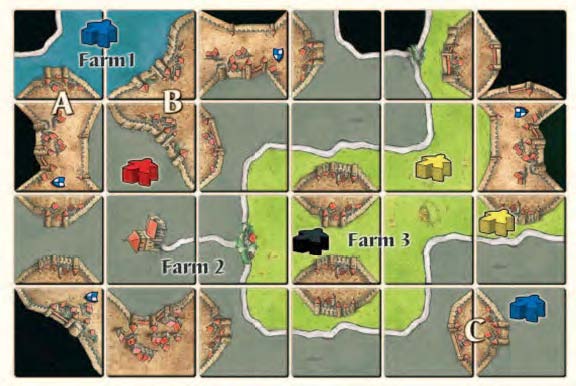
* Farm 1: BLUE owns farm 1. Two completed cities (A and B) border the farm. For each completed city BLUE scores 3 points (irrespective of their size), or a total of 6 points.
* Farm 2: RED and BLUE own farm 2. There are three completed cities (A, B and C) bordering or lying within this farm. RED and BLUE therefore score 9 points each.
Notice that cities A and B score points for BLUE on farm 1 as well as RED and BLUE on farm 2, since these cities border both farms. The city on the bottom left is incomplete, and so generates no points.
* Farm 3: YELLOW owns farm 3, since YELLOW has more farmers on it than BLACK. There are four completed cities bordering or lying within farm 3, so YELLOW scores 12 points.
Règles non officielles
- The players decide who starts the game by any method they choose—such as by rolling three followers. The first player to ‘roll’ a standing follower decides who plays first. (Thanks to Joff.)
- To determine the first player; each player draws a tile from the bag, the player that drew the tile with the most roads (0 to 4) plays first, if there is a tie for most roads, a draw-off takes place. This is repeated until someone wins. (Thanks to michael.)
- Take your next tile at the end of your turn, to give you time to think about placement and avoid analysis paralysis.
- Play with a three-tile hand. The abbey counts as part of your hand. Play your turn, including the builder, and then draw back up to three tiles. These tiles could be visible to all or hidden to the other players (Thanks to DavidP and youtch.)
- When playing with a bag for the tiles, the original starting tile may be put into the bag, and unplayable tiles can be put back into the bag rather than set to one side. (Thanks to dwhitworth.)
- Trees (bushes) on roads do not end the road—only houses do (when the road forks). This makes road building a lot more dynamic. (Thanks to Tobias.)
- When a tile is the only tile which can currently complete a structure, other players can offer to ‘buy’ it by offering points, trades counter, abbey, and so on. (Thanks to Deatheux.)
- If you place a tile that fills a hole in the playing field by touching something on all four adjacent sides, you get another turn. This helps motivate people to finish the board even if they do not get an advantage from the placement. (Does not apply to the abbey tile). (Thanks to viberunner.)
- Incomplete features at the end of the game do not score points at the end of the game. (Thanks to metoth.)
- The edge of the table limits the playing area. Thus, a player may not place a tile past the edge of the table or move the playing area to place a tile that would have been past the edge of the table. (Thanks to metoth for prompting this one, and to SkullOne for pointing out that this is an official rule from Hunters and Gatherers.)
- Table borders COMPLETE features as an abbey would. (Thanks to PreGy.)
- Use colored dice instead of meeples on the scoring track. Start out with the 6 showing on top. When the marker completes one lap, turn it to the number 1 to indicate it has completed one lap. This shows at a glance which player is on what lap and who's ahead. On the 100 space track it’s even easier to determine someone’s score at a glance. (Thanks to Carcking.)
Utilisation d’une table
A number of questions have been asked about rules related to the play area itself, including what happens when the edge of the area is reached, or if a table has to be used for play. The following clarifications are from Georg Wild from HiG (5/2013):
- The edge of the table is the limit for the game if, as stated in the rules, a table is used.
- The rules state that the starting tile is placed in the middle of the table. If all of the tiles are shifted to allow more room, the starting tile would no longer be in the middle. So in principle, total shifting of the tiles is not allowed. Additionally, with a manual shift of all of the tiles, the tiles and figures on the field can slip, which could lead to incorrect positioning of tiles or figures.
- Addition of a second table is possible if one of an appropriate height is added to the first table. If a table is extended (as with an additional panel), make sure that the tiles and figures on the playing field do not slip.
- Playing on the floor: The rules technically do not allow this, because the rules state that the first tile is placed in the middle of the table. Playing on the floor is not forbidden, however, if use of a table is not feasible. If the floor is used, tiles must be placed so all tiles are visible to all players. Tiles cannot be placed under the sofa, cabinet/shelf, etc.
- It is important generally, that all the players in the round agree how to play:
- Table - Standard
- Table - with "total shifting" of tiles
- Table - with extension
- Floor
- Continue to play fairly and not intentionally unfair to other players.
Ensemble des tuiles
Total des tuiles : 72 [17]
Notes
Pour les licences et les explications des icônes, veuillez visiter la page des icônes.
- ↑
 Ceci n’est pas mentionné dans les règles de la
Ceci n’est pas mentionné dans les règles de la  Big Box 1, la
Big Box 1, la  Big Box 2, la
Big Box 2, la  Big Box 3 et la
Big Box 3 et la  Big Box 4. le sixième joueur (gris) est intégré directement dans le jeu de base et non pas dans
Big Box 4. le sixième joueur (gris) est intégré directement dans le jeu de base et non pas dans  Auberges et Cathédrales. Cela rend les règles plus claires. En outre, la
Auberges et Cathédrales. Cela rend les règles plus claires. En outre, la  Big Box 5 ajoute des partisans violets et roses pour un maximum de 8 joueurs. Des meeples de couleurs supplémentaires peuvent être acquis en ligne.
Big Box 5 ajoute des partisans violets et roses pour un maximum de 8 joueurs. Des meeples de couleurs supplémentaires peuvent être acquis en ligne.
- ↑
 Ce paragraphe représente les règles actuelles de Hans im Glück. Les règles de Rio Grande Games stipulent que les joueurs décident entre eux qui sera le joueur titulaire, et les règles de Z-Man Games mentionnent les deux options.
Ce paragraphe représente les règles actuelles de Hans im Glück. Les règles de Rio Grande Games stipulent que les joueurs décident entre eux qui sera le joueur titulaire, et les règles de Z-Man Games mentionnent les deux options.
- ↑
 If you complete an unoccupied feature, it is not mandatory for you to place a follower on it. If you place a follower and occupy the just completed feature, you will score points for it (and remove your follower right away). Otherwise, you will not receive points for the feature.
If you complete an unoccupied feature, it is not mandatory for you to place a follower on it. If you place a follower and occupy the just completed feature, you will score points for it (and remove your follower right away). Otherwise, you will not receive points for the feature.
- ↑
 In the game there are crossings and junctions. But since all crossings have the same effect—namely, to bring a road to an end—it was decided to sacrifice the distinction between crossings and junctions (or T-crossings, or T-roads...?) in order to not unnecessarily complicate matters.
In the game there are crossings and junctions. But since all crossings have the same effect—namely, to bring a road to an end—it was decided to sacrifice the distinction between crossings and junctions (or T-crossings, or T-roads...?) in order to not unnecessarily complicate matters.
- ↑
 The RGG edition states rather confusingly that “a city is complete when the city is completely surrounded by a city wall and there are no gaps in the wall.” Obviously, a city cannot be completely surrounded by a wall, and the wall have gaps at the same time. It is the city itself which cannot have gaps, as the HiG rules make clear.
The RGG edition states rather confusingly that “a city is complete when the city is completely surrounded by a city wall and there are no gaps in the wall.” Obviously, a city cannot be completely surrounded by a wall, and the wall have gaps at the same time. It is the city itself which cannot have gaps, as the HiG rules make clear.
- ↑
 Note that the so-called ‘small city’ rule is no longer used in any edition. This rule stated that a city of two segments—the smallest possible completed city— scored only 2 points, or 1 point per tile. Pennants in a small city also scored only 1 point each. However, small cities are now scored in the same way as every other city: that is, 2 points for every city segment, and 2 points per pennant.
Note that the so-called ‘small city’ rule is no longer used in any edition. This rule stated that a city of two segments—the smallest possible completed city— scored only 2 points, or 1 point per tile. Pennants in a small city also scored only 1 point each. However, small cities are now scored in the same way as every other city: that is, 2 points for every city segment, and 2 points per pennant.
- ↑
 Note in the box that features are considered to be complete as soon as the tile is placed, although follower placement and scoring only occur afterwards. This is important when playing with
Note in the box that features are considered to be complete as soon as the tile is placed, although follower placement and scoring only occur afterwards. This is important when playing with  Mini n°1 – Les Aéronefs.
Mini n°1 – Les Aéronefs.
- ↑
 Okay, “never” is a long time. In reality, some special mechanics in some expansions (
Okay, “never” is a long time. In reality, some special mechanics in some expansions ( Le Festival tiles,
Le Festival tiles,  Princesse et Dragon, etc.) do allow return of farmers to their owners. (12/2014)
Princesse et Dragon, etc.) do allow return of farmers to their owners. (12/2014)
- ↑
 In determining farm size, farms can be limited by all kinds of barriers, for example, roads, cities, or rivers which cannot be circumvented, or the edge of the playing field. It can certainly happen that a farm covers almost the entire playing field, and there will likely be farms that remain open for the entire game.
In determining farm size, farms can be limited by all kinds of barriers, for example, roads, cities, or rivers which cannot be circumvented, or the edge of the playing field. It can certainly happen that a farm covers almost the entire playing field, and there will likely be farms that remain open for the entire game.
- ↑
 River segments also separate farms. (08/2014)
River segments also separate farms. (08/2014)
- ↑
 The graphic here suggests that it might also be a good idea to lie the follower being used as a scoring marker flat on the scoreboard as the "50" is passed.
The graphic here suggests that it might also be a good idea to lie the follower being used as a scoring marker flat on the scoreboard as the "50" is passed.
- ↑
 This is the first real difference to previously published editions, now having its own section and a description of point tiles, which were previously considered to be a part of the
This is the first real difference to previously published editions, now having its own section and a description of point tiles, which were previously considered to be a part of the  Auberges et Cathédrales.
Auberges et Cathédrales.
- ↑
 Note that, according to the RGG
Note that, according to the RGG  Big Box 3 rules, the last land tile placed could be an Abbey tile. According to these most recent rules, “If one or more players have not yet placed their Abbey tiles when the last landscape tile is drawn and placed, they may now do so, if possible, in clockwise order starting from the left of the person who placed the last tile. Then, the game ends.” This is a reversal of a previous FAQ, which used the statement, “The game is over when the last face-down land tile has been played.” This older statement was to specifically prevent players from placing any abbey tiles which they may still have in their hand after the last ‘normal’ land tile (from the stack, the bag, or the dispenser) had been played.
Big Box 3 rules, the last land tile placed could be an Abbey tile. According to these most recent rules, “If one or more players have not yet placed their Abbey tiles when the last landscape tile is drawn and placed, they may now do so, if possible, in clockwise order starting from the left of the person who placed the last tile. Then, the game ends.” This is a reversal of a previous FAQ, which used the statement, “The game is over when the last face-down land tile has been played.” This older statement was to specifically prevent players from placing any abbey tiles which they may still have in their hand after the last ‘normal’ land tile (from the stack, the bag, or the dispenser) had been played.
- ↑
 This describes what is known as the "third edition" method of scoring farms, the method currently accepted by all publishers.
This describes what is known as the "third edition" method of scoring farms, the method currently accepted by all publishers.
- ↑
 Question: What are the differences to the rules of the first edition, when Carcassonne won Game of the Year? Answer: The scoring of farms was not from the perspective of the farms themselves, as it is now, but rather from the perspective of the cities. For every city, you had to check how many farmers of each color were adjacent to it, irrespective of from which side. The player with the majority of adjacent farmers supplying a city would earn four points for it. Each city would as such only be scored once, and therefore earned more points. According to the old rules, BLUE would be the only one to score points, since two of his or her farmers are supplying the cities, even though they are on different farms. YELLOW has only one farmer adjacent to the city and goes home without anything. According to the new rules, both farmers earn points; and following the most recent rule changes, BLUE even earns points twice.
Question: What are the differences to the rules of the first edition, when Carcassonne won Game of the Year? Answer: The scoring of farms was not from the perspective of the farms themselves, as it is now, but rather from the perspective of the cities. For every city, you had to check how many farmers of each color were adjacent to it, irrespective of from which side. The player with the majority of adjacent farmers supplying a city would earn four points for it. Each city would as such only be scored once, and therefore earned more points. According to the old rules, BLUE would be the only one to score points, since two of his or her farmers are supplying the cities, even though they are on different farms. YELLOW has only one farmer adjacent to the city and goes home without anything. According to the new rules, both farmers earn points; and following the most recent rule changes, BLUE even earns points twice.
- ↑
 The HiG rules do not have any instructions regarding what to do in case of a tie. The RGG rules state that tied players “rejoice in their shared victory.” The ZMG rules state, “In case of a tie, play another game to determine the winner!”
The HiG rules do not have any instructions regarding what to do in case of a tie. The RGG rules state that tied players “rejoice in their shared victory.” The ZMG rules state, “In case of a tie, play another game to determine the winner!”
- ↑
 La
La  Big Box 5 comprend en fait ces 72 tuiles avec le dos standard ainsi qu’une tuile de départ séparée. Ainsi, il y a une tuile supplémentaire avec une section de ville et une route horizontale (CRFR, voir la référence consolidée des tuiles) dans le jeu de base de la
Big Box 5 comprend en fait ces 72 tuiles avec le dos standard ainsi qu’une tuile de départ séparée. Ainsi, il y a une tuile supplémentaire avec une section de ville et une route horizontale (CRFR, voir la référence consolidée des tuiles) dans le jeu de base de la  Big Box 5.
Big Box 5.
